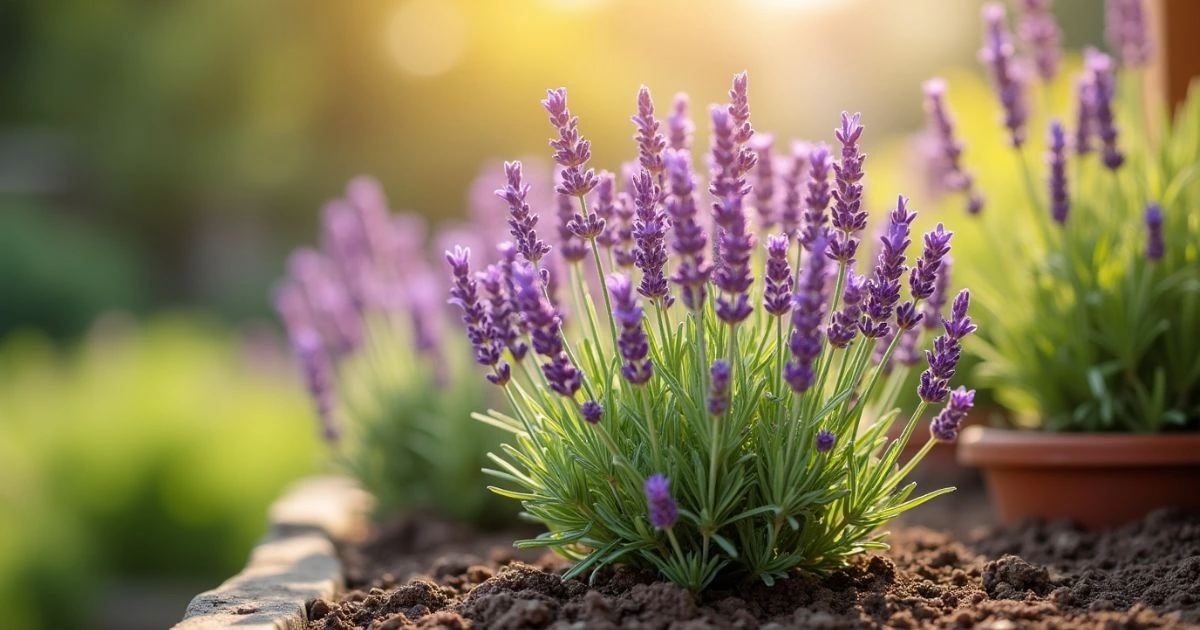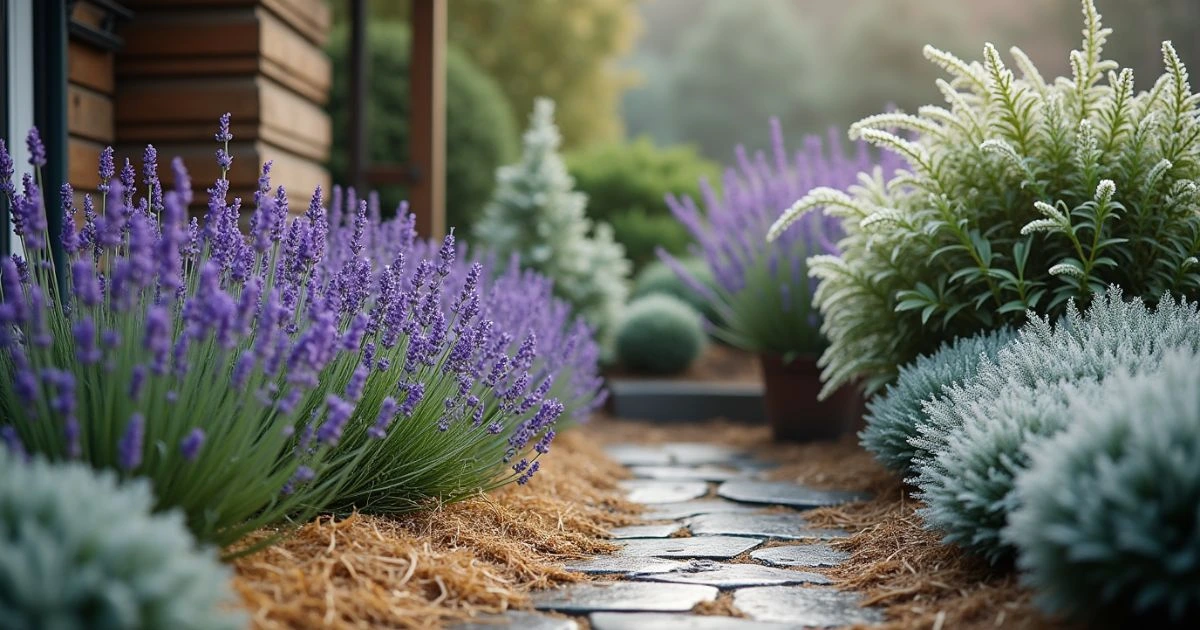Imagine stepping into a garden bursting with lush lavender bushes. The air is filled with their soothing aroma, and their purple blossoms sway gently in the breeze. Lavender isn’t just a plant; it’s a source of tranquility, beauty, and utility. Whether you’re new to gardening or a seasoned pro, growing a thriving lavender herb plant requires knowing a few key tips. Let’s explore the steps to ensure your lavender grows strong and healthy while enhancing your outdoor space.
Table of Contents
Understanding the Lavender Herb Plant
Lavender is a resilient perennial celebrated for its vivid blooms and aromatic foliage. Originating from the Mediterranean, this herb is a beloved staple in gardens across the globe. But not all lavender varieties are the same. Selecting the right type for your environment is the first step in successful lavender bush care.
Popular Lavender Varieties
- English Lavender (Lavandula angustifolia): Perfect for cooler climates with a strong fragrance. Ideal for making sachets and oils.
- French Lavender (Lavandula dentata): Known for its serrated leaves and milder scent. A great choice for decorative pots.
- Spanish Lavender (Lavandula stoechas): Unique, pine-cone-like flowers that thrive in warm, dry regions.
Each variety offers unique traits. For instance, Spanish lavender grows well in rock gardens, while English lavender performs better in temperate climates. Choosing a variety suited to your conditions ensures thriving growth.
| Lavender Variety | Ideal Climate | Fragrance Level | Uses |
| English Lavender | Cool, temperate | Strong | Oils, sachets |
| French Lavender | Mild winters | Moderate | Decorative pots |
| Spanish Lavender | Warm, dry | Mild | Garden borders |
Choosing the Perfect Location for Lavender

Does lavender need full sun? Absolutely! Lavender thrives in sunlight, requiring at least six to eight hours of direct sun daily. Placing your lavender plant outdoors in a sunny, well-ventilated spot ensures its health and longevity.
Site Selection Tips
- Sunlight: Choose a location with full sun exposure. A south-facing garden bed or balcony is ideal.
- Soil: Lavender requires well-drained soil with a neutral to slightly alkaline pH of 6.5 to 7.5. If your soil tends to hold water, mix in sand or gravel to improve drainage.
- Airflow: Proper air circulation prevents fungal diseases and promotes robust growth.
For potted lavender, choose terracotta pots, as they provide better airflow to the roots. Make sure the pot has drainage holes to prevent root rot.
Adding mulch around the base of your lavender plants can also help retain soil moisture while regulating temperature. However, ensure the mulch doesn’t touch the base of the plant to prevent rot.
Watering and Feeding Lavender

Lavender’s Mediterranean roots make it well-suited to dry conditions. Overwatering is one of the most common mistakes gardeners make when caring for lavender herb plants. Here’s how to optimize your watering routine.
How Often to Water
- New Plants: Water once or twice weekly until roots establish.
- Established Plants: Allow the soil to dry out completely between waterings. Generally, this involves watering every two to three weeks during the growing season.
Feeding Lavender
Lavender prefers nutrient-poor soil. Excessive fertilizing can result in leggy growth and reduced blooms. Use a light, organic fertilizer in spring to give your plant a gentle boost.
Additionally, you can add a small amount of lime to your soil if you’re growing lavender herb plants in areas with acidic conditions. This simple adjustment can help maintain the plant’s desired pH level.
Pruning Lavender for Healthy Growth

Pruning is essential for lavender bush care. Regular trimming prevents the plant from becoming woody and encourages new growth.
Pruning Steps
- Timing: Prune after flowering in late summer or early spring.
- Tools: Use clean, sharp shears to avoid damaging the stems.
- Method: Remove about one-third of the plant’s height, but avoid cutting into woody stems.
For example, if your lavender herb plant has grown unevenly, shaping it through pruning helps maintain its aesthetic appeal while boosting its vitality.
Pruning also helps stimulate more flower production in your lavender. A well-pruned lavender bush is not only visually appealing but also more productive.
Protecting Lavender During Winter

Lavender’s hardiness varies by variety. English lavender can withstand frost, but French and Spanish types need extra care.
Winterizing Your Lavender Plant
- Mulching: Apply a layer of straw or bark mulch around the base to insulate roots.
- Potted Lavender: Move pots to a sheltered location or indoors near a sunny window.
- Watering: Reduce watering frequency to prevent root rot during dormancy.
Proper winter care ensures your lavender plant outdoor stays healthy and ready to bloom again in spring. For added protection, consider using frost covers for garden-planted lavender in colder climates.
Propagating Lavender Herb Plants

Want to expand your lavender collection? Propagation is a simple and affordable method to grow additional plants. There are three primary methods: cuttings, seeds, and layering.
How to Propagate Lavender
- Cuttings: Collect softwood cuttings in spring or semi-hardwood cuttings in summer. Plant them in a mix of sand and compost, keeping the soil moist until roots develop.
- Seeds: While growing lavender from seeds takes patience, it’s rewarding. Sow seeds in a seed-starting mix and keep them in a warm spot.
- Layering: Bend a low branch to the ground, secure it with a pin, and cover it with soil. After roots develop, separate the new plant from the parent.
For instance, propagating from cuttings ensures that new plants retain the traits of the parent variety. This method is especially useful when growing a specific lavender herb plant that performs exceptionally well in your garden.
Creative Uses for Lavender
Lavender isn’t just a garden delight; it’s also incredibly versatile. From the kitchen to DIY crafts, lavender has a range of uses.
Culinary Ideas
- Lavender Tea: Steep dried lavender buds in hot water for a calming beverage.
- Lavender Shortbread Cookies: Add crushed buds to your cookie dough for a floral twist.
DIY Crafts
- Sachets: Sew small pouches filled with dried lavender to freshen drawers and closets.
- Essential Oils: Infuse lavender in a carrier oil to create a soothing massage blend.
| Recipe | Ingredients | Steps |
| Lavender Tea | Dried buds, water | Boil water, steep buds for 5 minutes. |
| Lavender Shortbread Cookies | Butter, sugar, lavender | Mix, bake at 350°F for 12 minutes. |
| DIY Lavender Essential Oil | Lavender, carrier oil | Infuse oil with lavender for 2 weeks. |
In addition to these, try adding lavender to homemade bath salts for a spa-like experience. The herb’s soothing properties make it a fantastic ingredient for relaxation products.
Common Problems and Solutions
Lavender is resilient, but it’s not immune to challenges. Knowing how to troubleshoot common issues can save your plant.
Pests
- Aphids: Spray the plant with a mix of water and dish soap.
- Whiteflies: Introduce natural predators like ladybugs.
Diseases
- Root Rot: Prevent by planting in well-drained soil and avoiding overwatering.
- Fungal Spots: Improve airflow and prune affected areas.
If your lavender plant’s leaves turn yellow, it could indicate overwatering or poor drainage. Regularly checking soil moisture and ensuring adequate drainage can help avoid these issues.
Growing Lavender Indoors
If outdoor gardening isn’t an option, you can still enjoy lavender indoors.
Indoor Lavender Care
- Lighting: Place the pot in a sunny window that receives at least six hours of light daily.
- Watering: Allow the soil to dry out between waterings.
- Humidity: Keep indoor humidity below 50% to mimic Mediterranean conditions.
For example, rotating the pot weekly ensures even growth as the plant reaches for sunlight. If you notice leggy growth, consider supplementing natural light with grow lights.
Benefits of Growing Lavender
Lavender offers more than aesthetic appeal. Here are some benefits you can enjoy:
- Stress Relief: Lavender’s fragrance has calming properties, perfect for aromatherapy.
- Pollinator Attraction: Bees and butterflies flock to lavender, supporting your garden’s ecosystem.
- Versatility: Use lavender in teas, sachets, or essential oils.
A thriving lavender herb plant transforms your space into a haven of relaxation and beauty. Additionally, lavender can act as a natural pest deterrent, keeping mosquitoes and moths at bay.
Conclusion: Your Journey to Thriving Lavender
Caring for a lavender herb plant is an enriching experience. By following these tips, you’ll not only grow a beautiful plant but also create a source of peace and creativity. Start small, and soon, your garden or home will be bursting with fragrant blossoms. Now is the perfect time to plant lavender and enjoy its endless benefits.
FAQ: Lavender Herb Plant Care
Q1: Does lavender need full sun?
Yes, lavender thrives in full sun. Make sure it receives at least six hours of sunlight each day.
Q2: Can I grow lavender indoors?
Yes, choose a sunny windowsill and ensure good drainage for indoor lavender.
Q3: How often should I water lavender?
Water new plants weekly and established plants every two to three weeks.
Q4: What’s the best fertilizer for lavender?
Use a light organic fertilizer in spring. Avoid high-nitrogen options.
Q5: Can lavender grow in clay soil?
Lavender struggles in clay soil unless amended with sand or gravel for drainage.
Q6: Where can I buy lavender plants?
Lavender plants are available at garden centers, nurseries, and online retailers.
Q7: How do I propagate lavender?
Take softwood cuttings in spring or use layering methods to grow new plants.
Q8: Why is my lavender not flowering?
Insufficient sunlight or over-fertilizing may hinder blooming.
Q9: What is the lifespan of a lavender plant?
With proper care, lavender can live 10-15 years.
Q10: How do I protect lavender in winter?
Use mulch for insulation and move potted plants to sheltered spots.
With this knowledge, you’re ready to embark on your lavender-growing journey. Happy gardening!


